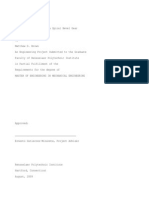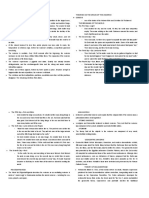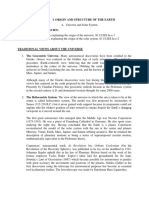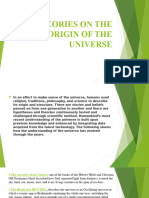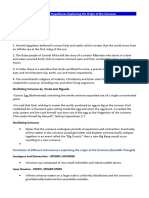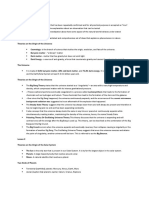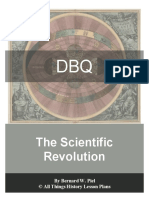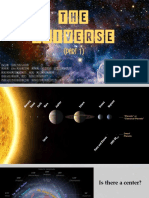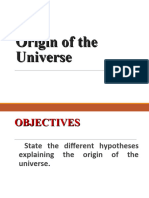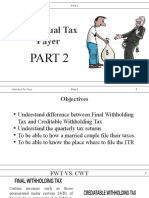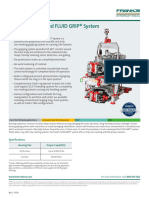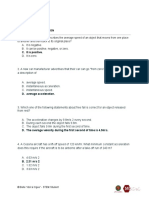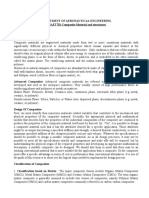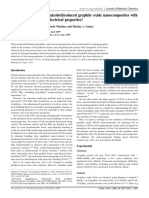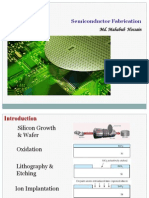0 ratings0% found this document useful (0 votes)
9 viewsEarth and Life Science
Earth and Life Science
Uploaded by
Ems Teope1. The universe includes all matter, energy, and space, from the smallest particles to the largest structures. It contains both visible and invisible components like dark matter.
2. Scientists theorize that the universe began from an infinitely small, dense, and hot point that expanded exponentially in an event known as the Big Bang.
3. The universe has continued expanding and cooling over billions of years, allowing the formation of protons, neutrons, atoms, stars, galaxies, and all cosmic structures in the observable universe.
Copyright:
© All Rights Reserved
Available Formats
Download as PPTX, PDF, TXT or read online from Scribd
Earth and Life Science
Earth and Life Science
Uploaded by
Ems Teope0 ratings0% found this document useful (0 votes)
9 views43 pages1. The universe includes all matter, energy, and space, from the smallest particles to the largest structures. It contains both visible and invisible components like dark matter.
2. Scientists theorize that the universe began from an infinitely small, dense, and hot point that expanded exponentially in an event known as the Big Bang.
3. The universe has continued expanding and cooling over billions of years, allowing the formation of protons, neutrons, atoms, stars, galaxies, and all cosmic structures in the observable universe.
Copyright
© © All Rights Reserved
Available Formats
PPTX, PDF, TXT or read online from Scribd
Share this document
Did you find this document useful?
Is this content inappropriate?
1. The universe includes all matter, energy, and space, from the smallest particles to the largest structures. It contains both visible and invisible components like dark matter.
2. Scientists theorize that the universe began from an infinitely small, dense, and hot point that expanded exponentially in an event known as the Big Bang.
3. The universe has continued expanding and cooling over billions of years, allowing the formation of protons, neutrons, atoms, stars, galaxies, and all cosmic structures in the observable universe.
Copyright:
© All Rights Reserved
Available Formats
Download as PPTX, PDF, TXT or read online from Scribd
Download as pptx, pdf, or txt
0 ratings0% found this document useful (0 votes)
9 views43 pagesEarth and Life Science
Earth and Life Science
Uploaded by
Ems Teope1. The universe includes all matter, energy, and space, from the smallest particles to the largest structures. It contains both visible and invisible components like dark matter.
2. Scientists theorize that the universe began from an infinitely small, dense, and hot point that expanded exponentially in an event known as the Big Bang.
3. The universe has continued expanding and cooling over billions of years, allowing the formation of protons, neutrons, atoms, stars, galaxies, and all cosmic structures in the observable universe.
Copyright:
© All Rights Reserved
Available Formats
Download as PPTX, PDF, TXT or read online from Scribd
Download as pptx, pdf, or txt
You are on page 1of 43
What Is the Universe?
The universe is everything that exists, from the
smallest particles to the largest ones, together
with all matter and energy. The universe
includes visible and invisible things, such as
dark matter, the great, secret component of the
cosmos. The search for dark matter is currently
one of the most important tasks of cosmology.
Dark matter may literally determine the density
of all of space, as well as decide the destiny of
the universe. Did you know that, second by
second, the universe grows and grows?
1. Scientists theorize that, from nothing, something infinitely
small, dense, and hot appeared.
All that exists today was compressed into a ball smaller than
the nucleus of an atom.
2. At the closest moment to zero time, which physics has been
able to reach, the temperature is extremely
high. Before the universe's inflation, a superforce governed
everything.
3. The universe is unstable. Only 10-38 seconds after the big-
bang, the universe increases in size more than a trillion trillion
trillion times. The expansion of the universe and the division of
its forces begin.
4. The universe experiences a gigantic cool down. Gravity has
already become distinguishable, and the electromagnetic force
and the strong and weak nuclear interactions appear
5. Protons and neutrons appear, formed by three
quarks a piece. Because all light is trapped within the web of
particles, the universe is still dark.
6. The electrons and their antiparticles, positrons, annihilate
each other until the positrons disappear. The remaining
electrons form atoms
Theories on the Origin of the Universe
•Genesis one of the books of the Hebrew Bible and Christian Old
Testament,
• The beginning of the world
The First Day—Light
God created the sky and the earth. At first, the earth was
completely empty. There was nothing on the earth. Darkness
covered the ocean, and God’s Spirit moved Over a the water.
Then God said, “Let there be light!” And light began to shine. He
saw the light, and he knew that it was good. Then he separated
the light from the darkness.God named the light “day,” and he
named the darkness “night.” There was evening, and then there
was morning. This was the first day.
The Second Day—Sky
Then God said, “Let there be a space to separate the water into
two parts!” So God made the space and separated the water.
Some of the water was above it, and some of the water was
below it. God named that space “sky.” There was evening, and
then there was morning. This was the second day. The Third
Day—Dry Land and Plants
Then God said, “Let the water under the sky be gathered
together so that the dry land will appear.” And it happened. God
named the dry land “earth,” and he named the water that was
gathered together “seas.” And God saw that this was good.
The Fourth Day—Sun, Moon, and Stars
Then God said, “Let there be lights in the sky. These lights will
separate the days from the nights. They will be used for signs to
show when special meetings begin and to show the days and
years. They will be in the sky to shine light on the earth.” And it
happened. So God made the two large lights. He made the
larger light to rule during the day and the smaller light to rule
during the night. He also made the stars. God put these lights in
the sky to shine on the earth. He put them in the sky to rule
over the day and over the night. They separated the light from
the darkness. And God saw that this was good. There was
evening, and then there was
morning. This was the fourth day.
The Fifth Day—Fish and Birds
Then God said, “Let the water be filled with many living things,
and let there be birds to fly in the air over the earth.” So God
created the large sea animals. He created all the many living
things in the sea and every kind of bird that flies in the air. And
God saw that this was good. God blessed all the living things in
the sea and told them to have many babies and fill the seas.
And he blessed the birds on land and told them to have many
more babies.
There was evening, and then there was morning. This was the
fifth day.
The Sixth Day—Land Animals and People
Then God said, “Let the earth produce many kinds of living
things. Let there be many different kinds of animals. Let there
be large animals and small crawling animals of every kind. And
let all these animals produce more animals.” And all these
things happened. So God made every kind of animal. He made
the wild animals, the tame animals, and all the small crawling
things. And God saw that this was good. Then God said, “Now
let’s make human who will be like us. They will rule over all the
fish in the sea and the birds in the air. They will rule over all the
large animals and all the little things that crawl on the earth.”
So God created humans in his own image. He created them to
be like himself. He created them male and female. God blessed
them and said to them, “Have many children. Fill the earth and
take control of it. Rule over the fish in the sea and the birds in
the air. Rule over every living thing that moves on the earth.”
God said, “I am giving you all the grain bearing plants and all the
fruit trees. These trees make fruit with seeds in it. This grain and
fruit will be your food. And I am giving all the green plants to
the animals. These green plants will be their food. Every animal
on earth, every bird in the air, and all the little things that crawl
on the earth will eat that food.” And all these things happened.
God looked at everything he had made. And he saw that
everything was very good. There was evening, and then there
was
morning. This was the sixth day.
The Seventh Day—Rest
So the earth, the sky, and everything in them were finished. God
finished the work he was doing, so on the seventh day he rested
from his work. God blessed the seventh day and made it a holy*
day. He made it special because on that day he rested from all
the work he did while creating the world.
Theories on the Origin of the Universe
* The Hindu text Rigueda describes the universe as an
oscillating universe in which a “ cosmic egg” or Brahmanda
containing the whole universe – including the sun, moon,
planets, and space
* Anagoras believed in primordial universe and explain that
the original state of the cosmos was a primordial mixtures of all
ingredients
* Leucippus and Democritus believed in atomic universe. They
held that the universe was composed of very small, indivisible
and indestructible atoms
Geocentric Model Before telescopes, binoculars, and modern
observatories existed, little was known about the Earth. Many
believed that the Earth was fixed and that the Sun, the Moon,
and the five known planets orbited it in circles. This geocentric
model was promoted by the Egyptian astronomer Claudius
Ptolemy, who in the 2nd century AD compiled the
astronomical ideas of the ancient Greek astronomers (in
particular, those of Aristotle, who had proposed the Earth as
the center of the universe, with the celestial objects revolving
around it). Although other ancient astronomers, such as
Aristarchus of Samus, proposed that the Earth was round and
rotated around the Sun, Aristotle’s ideas were accepted as true
for 16 centuries, and at times Aristotle’s ideas were defended
and preserved by the Roman Catholic Church.
• Heliocentric Model In 1543, a few months before his
death, Nicolaus Copernicus published the book
Derevolutionibus orbium coelestium, inaugurating what
is now known as the Copernican Revolution. The Polish
astronomer developed the heliocentric theory (from
helios, the Greek word for “the Sun”), which contradicted
the geocentric theory. Copernicus’s new postulate
inverted the traditional relationship of the Sun and the
Earth, identifying the Sun as the center of the universe
and the Earth as one of many solar satellites. Copernicus
argued that spheres moved in endless, circular orbits.
Since the universe and all the celestial bodies were
thought to be spherical, he argued that their movements
must also be circular and uniform (the Ptolemaic system
considered the planets’ circuits to be irregular).
• Copernicus reasoned that, since the movements of
the planets appeared to be irregular, the Earth must
not be the center of the universe. These discoveries
were contrary to the views promulgated by the
Roman Catholic Church. In fact, both Roman Catholics
and Protestants suppressed any writings advocating
these beliefs. When Galileo Galilei was brought to
trial by the Roman Catholic Church for advocating the
Copernican theory, he was forced to renounce his
views.
• In 1687, Sir Isaac Newton describe the universe as a static,
steady-state, infinite universe. In his description of the
universe, matter at a large scale is uniformly distributed.
• French philosopher Rene Descartes outlined a Cartesian
vortex model of the universe. His model involved a system of
huge swirling whirlpools of fine matter.
•Albert Einstein was no different from Newton
The Big-Bang theory
This theory was proposed by Edwin Hubble (1889-1953)
Hubble proposed that the primordial mass of the universe
was once concentrated in an extremely hot and dense fireball
called YLEM which underwent a gigantic explosion billions of
years ago. After its explosion and cooled causing the formation
of subatomic particles.
As the YLEM continued to expand, it also continued to cool
giving way for gases to condense, forming the galaxies. As
condensation of gases continued, stars, planets and satellites
were formed.
The big bang theory helped solve the enigma of the early
moments of the universe. What has yet to be resolved is the
mystery surrounding the future that awaits. To unravel this
mystery, the total mass of the universe must be known, but that
figure has not yet been reliably determined. The most recent
observations have removed some of this uncertainty. It seems
that the mass of the universe is far too little to stop its
expansion. If this is this case, the universe's present growth is
merely the last step before its total death in complete darkness
The Steady State theory
This theory was proposed by three scientists: Herman Bondi,
Thomas Gold and Fred Hoyle. The theory suggests that there is
no beginning nor end to the universe
The Oscillating Universe theory
In this theory Fred Hoyle suggests that the universe is
expanding as in the big-bang, but its expansion would slow
down and would eventually come to a halt because of mutual
gravitational attraction. The galaxies would begin to contract,
bringing back the materials to the original fireball, and another
explosion would commence again.
Inflationary Universe
American physicist Alan Guth proposed a model of the universe
based on big bang theory as horizon and flatness problems
Multiverse
Russian-American physicist Andrei Linde developed the concept
of inflationary universe from his chaotic inflationary theory in
1983. This theory sees the universe as just one of the many
“bubbles”
Origin of The Solar System
Models of the solar system
In the 16th century, a Greek philosopher named Claudius
Ptolemy developed a Geocentric idea about the universe.
Ptolemy believed that the earth was the center of the universe
and that the sun, moon, and planets revolved around it.
The wisdom and courage of a young Polish lawyer, economist,
physician and monk of a Polish Church by the name of
Copernicus revolutionized Ptolemy’s idea and introduced the
Heliocentric model of the universe. After careful observations,
gathering of data and mathematical calculations, Copernicus
was convinced that the sun is the center of the solar system and
the different planets including the earth revolve around it
The Solar System
Among the millions and millions of stars that form the Milky
Way galaxy, there is a medium-sized one located in one of the
galaxy's arms—the Sun. To ancient people, the Sun was a god;
to us, it is the central source of energy that generates heat,
helping life exist. This star, together with the planets and other
bodies that spin in orbits around it, make up the solar system,
which formed about 4.6 billion years ago. The planets that
rotate around it do not produce their own light. Instead, they
reflect sunlight. After the Earth, Mars is the most explored
planet. Olympus Mons, the largest volcano in the entire solar
system. It is almost two-and-a-half times as high as the tallest
peak on the Earth, Mount Everest.
Attracted by a Star
Planets and their satellites, asteroids and other rocky objects,
and an incalculable number of comet like objects, some more
than 1 trillion miles (1.6 trillion km) from the Sun, make up the
solar system. In the 17th century, astronomer Johannes Kepler
proposed a model to interpret the dynamic properties of the
bodies of the solar system. According to this interpretation, the
planets complete elliptical trajectories, called orbits, around the
Sun. In every case, the movement is produced by the influence
of the gravitational field of the Sun. Today, as part of a rapidly
developing field of astronomy, it is known that planet or planet
like bodies also orbit other stars.
.
Theories of the origin of the solar system
A. The Planetesimal Theory
This theory was first proposed by French scientist, Georges
Comte de Buffon in 1778. According to this theory, ages ago,
the sun collided with another star, the collision caused large
masses of materials from two stars to be thrown in space.
Eventually the materials cooled and condensed to form small
bodies which, in the course of time, became planets
B. The Companion Star Theory
A Modern British astronomer named Fred Hoyle proposed that
the sun once a companion star. This star explode when collided
with the sun and its materials were held by the sun’s gravitation.
From this various planets and other bodies in the solar system
were formed.
The Nebular Hypothesis
This was proposed by Marquis de Laplace, a French
astronomer in 1796. According to this theory, the source of the
material of the solar system was a vast, saucer-shaped nebula,
similar to protostar. This nebula was swirling slowly in space.
The swirling nebula eventually cooled and shrank causing it to
spin faster in space. The spinning caused rings of materials to
break away from its outer edge. The rings gave rise to planets
and the center of the nebula condensed and become the sun
The orbits of planets
Each member of the solar system has a definite orbit around
the sun. the orbits of the planets are the result of the delicate
balance of forces existing between the sun and the planets. We
call this force gravitational pull. On the other hand another
force, the force of the planet’s own inertia, tends to throw the
planets off into space, preventing them from being attracted to
the sun
Life on Earth
The Blue Planet
The Earth is known as the blue planet because of the color of
the oceans that cover two thirds of its surface. This planet, the
third planet from the Sun, is the only one where the right
conditions exist to sustain life, something that makes the Earth
special. It has liquid water in abundance, a mild temperature,
and an atmosphere that protects it from objects that fall from
outer space. The atmosphere also filters solar radiation thanks
to its ozone layer. Slightly flattened at its poles and wider at its
equator, the Earth takes 24 hours to revolve once on its axis.
Greek philosopher and mathematician named Eratosthenes
calculated the size of the earth.
The Phenomenon of Life
Water, in liquid form, makes it possible for life to exist on the
Earth, the only planet where temperatures vary from 32° F to
212° F (0° C to 100° C), allowing water to exist as a liquid. The
Earth’s average distance from the Sun, along with certain other
factors, allowed life to develop 3.8 billion years ago. 70% of the
Earth’s surface is water. From space, the planet looks blue.
Magnetism and Gravity
The Earth’s magnetic field originates in the planet’s outer core,
where turbulent currents of molten iron generate both electric
and magnetic fields. The orientation of the Earth’s magnetism
varies over time, causing the magnetic poles to fluctuate
EVAPORATION Because of the Sun’s energy, the water evaporates,
entering the atmosphere from oceans and, to a lesser extent, from
lakes, rivers, and other sources on the continents.
CONDENSATION The Earth’s winds transport moisture-laden air
until weather conditions cause the water vapor to condense into
clouds and eventually fall to the ground as rain or other forms of
precipitation.
PRECIPITATION The atmosphere loses
water through condensation. Gravity causes
rain, snow, and hail. Dew and frost directly
alter the state of the surface they cover.
Earth is the third planet from the Sun and is the largest of
the terrestrial planets. The Earth is the only planet in our solar
system not to be named after a Greek or Roman deity.
The Earth was formed approximately 4.54 billion years ago and
is the only known planet to support life.
Earth, the only object in the Universe known to harbor life. It is
the densest planet in the Solar System.
Radius: 6,371 km
Age: 4.543 billion years
Surface Area: 510.1 million km²
Mass: 5.972 × 10^24 kg
Gravity: 9.807 m/s²
Among the inner planets (Mercury, Venus, Earth, the Moon, and
Mars), Earth is unique because of its size and distance from the
Sun. It is large enough to develop and retain an atmosphere and
a hydrosphere. Temperature ranges are moderate, such that
water can exist on its surface as liquid, solid, and gas.
Is a delicate blue ball wrapped in filmy white clouds. The water
and swirling clouds that dominate Earth’s surface underline the
importance of water in Earth’s systems. The cold polar regions
are buried with ice, and the warm tropics are speckled with
clouds and greenery. The rocks of the high continents are
strongly deformed and older than the rocks of the ocean basins.
Earth has active volcanoes, a dynamic interior, and no large
impact craters are visible on its surface. Diameter 12,800 km
Density 5.55 g/cm3
REVOLUTION: It takes the Earth 365 days, 5 hours, and 57
minutes to travel once around the Sun.
ROTATION: The Earth revolves on its axis in 23 hours and 56
minutes.
The Moon, our only natural satellite, is four times smaller than
the Earth and takes 27.32 days to orbit the Earth
We live on the Earth, but do we know what we are standing on?
The planet is made up of layers of various materials, such as
solid and molten rock, which in turn are composed of such
elements as iron, nickel, and silicon. Our atmosphere is the
layer of gases surrounding our planet. One of these gases,
oxygen, does a very special job—it permits life to exist.
Above the Surface
The existence of life on our planet would be
impossible without the atmosphere that provides the
air we breathe and the water we drink; it also
protects us from the Sun’s harmful radiation, while
simultaneously maintaining mild temperatures by
retaining the Sun’s warmth. The atmosphere is about
435 miles thick (700 km) but lacks defined limits.
Internal Structure
We live on a rocky surface similar to a shell. The rocks we live with are made
mostly of oxygen and silicon, but underneath them is the mantle, made of much
heavier rocks. The mantle also surrounds the inner and outer cores with a
region of constantly boiling liquid metals, creating the convective currents that
generate the Earth’s magnetic field. The inner core, solid because of the great
pressure put upon it, is the densest part of the planet.
Lithosphere and Hydrosphere
The hydrosphere, the liquid part of the Earth, includes the
oceans, lakes, rivers, underground waters, snow, and ice. It
almost completely covers the crust, surrounds the shores of the
continents, and covers 71 percent of the Earth’s surface. The
lithosphere is a superficial, elastic region that is 4 to 7 miles (6
to 11 km) thick under the oceans and up to 43 miles (70 km)
thick under mountain ranges.
Hydrosphere and Lithosphere
The lithosphere includes the crust and the upper portion of the
mantle, and the hydrosphere includes liquid water, covering 71
percent of the Earth’s surface in lakes,
rivers, and five oceans.
The Atmosphere
- Our atmosphere is unique in the
solar system. It is composed of 78%
nitrogen, 21% oxygen, and minor
amounts of other gases, such as carbon
dioxide (only 0.035%) and water vapor.
The earliest atmosphere was much
different. It was essentially oxygen-free
and consisted largely of carbon dioxide
and water vapor. The present carbon
dioxide-poor atmosphere developed as
soon as limestone began to form in the
oceans, tying up the carbon dioxide.
Oxygen was added to the atmosphere
later, when plants evolved. As a result of
photosynthesis, plants extracted carbon
dioxide from the primitive atmosphere
and expelled oxygen into it. Thus, the
oxygen in the atmosphere is and was
produced by life.
The hydrosphere
- is the total mass of water on the surface of our planet. Water
covers about 71% of the surface. About 98% of this water is in the
oceans. Only 2% is in streams, lakes, groundwater, and glaciers. Thus, it
is for good reason that Earth has been called “the water planet.” It has
been estimated that if all the irregularities of Earth’s surface were
smoothed out to form a perfect sphere, a global ocean would cover
Earth to a depth of 2.25 km. Again, it is this great mass of water that
makes Earth unique. Water permitted life to evolve and flourish; every
inhabitant on Earth is directly or indirectly controlled by it. All of Earth’s
weather patterns, climate, rainfall, and even the amount of carbon
dioxide in the atmosphere are influenced by the water in the oceans.
The hydrosphere is in constant motion; water evaporates from the
oceans and moves through the atmosphere, precipitating as rain and
snow, and returning to the sea in rivers, glaciers, and groundwater. As
water moves over Earth’s surface, it erodes and transports weathered
rock material and deposits it. These actions constantly modify Earth’s
landscape. Many of Earth’s distinctive surface features are formed by
action of the hydrosphere.
The Biosphere
- The biosphere is the part
of Earth where life exists. It
includes the forests, grasslands,
and familiar animals of the land,
together with the numerous
creatures that inhabit the sea and
atmosphere. Microorganisms
such as bacteria are too small to
be seen, but they are probably
the most common form of life in
the biosphere. As a terrestrial
covering, the biosphere is
discontinuous and irregular; it is
an interwoven web of life existing
within and reacting with the
atmosphere, hydrosphere, and
lithosphere. It consists of more
than 1.6 million described species
and perhaps as many as 3 million
more not yet described. Each
species lives within its own
limited environmental setting.
The solid materials of Earth are separated into layers according
to composition and mechanical properties. From outside in, the
compositional layers are (1) CRUST (2) MANTLE and (3) CORE
-Layers based on physical properties are
- (1) LITHOSPHERE
- (2) ASTENOSPHERE
- (3) MESOSPHERE
- (4) OUTER CORE and
-(5) INNER CORE.
• Internal Structure Based on
Chemical Composition:
• CRUST
- is the outermost solid shell of a rocky
planet or natural satellite, which is
chemically distinct from the underlying
mantle.
• MANTLE
• - is a layer between the crust and the outer
core. Earth's mantle is a silicate rocky shell
with an average thickness of 2,886
kilometers (1,793 mi). The mantle makes
up about 84% of Earth's volume. It is
predominantly solid but in geological time it
behaves as a very viscous fluid.
• CORE
• - consists of the innermost layer(s) of a
planet; which may be composed of solid
and liquid layers.
INNER CORE is made of the same metals as the outer core,
but, despite its high temperature, its center is solid because of the
enormous pressure that compresses it.
OUTER CORE The outer layer of the core is liquid, consisting of molten iron and
nickel. Its temperature is lower than that of the inner core and it is under less
pressure. The motion of the molten material produces the geomagnetic field.
INNER MANTLE The solid, intermediate layer
between the core and the crust. High temperature S
and P waves pass through it because of its contact
with the core.
OUTER MANTLE As a result of the high temperatures, the
materials dilate and produce a continuous ascending
movement that generates convection currents and
the forces that cause the changes to the Earth’s
crust.
You might also like
- HWK Chapter2Document5 pagesHWK Chapter2Carlos Serrano100% (3)
- GRADE 11 EARTH AND LIFE Quarter 1Document3 pagesGRADE 11 EARTH AND LIFE Quarter 1Chantal Althea100% (17)
- Aliabadi Aa Turbulence A Fundamental Approach For ScientistsDocument296 pagesAliabadi Aa Turbulence A Fundamental Approach For ScientistsStrahinja DonicNo ratings yet
- Grade 11 Origin of The UniverseDocument19 pagesGrade 11 Origin of The Universeknipxin88% (32)
- Chapter 1 Origin and Structure of The EarthDocument9 pagesChapter 1 Origin and Structure of The EarthBinibini100% (6)
- Copernicus and Kepler: A New View of The Universe: Geocentric TheoryDocument8 pagesCopernicus and Kepler: A New View of The Universe: Geocentric Theoryapi-287069252No ratings yet
- Design and Analysis of A Spiral Bevel GearDocument90 pagesDesign and Analysis of A Spiral Bevel Gearsigit-sahyanto-61220% (1)
- Earth and LifeDocument7 pagesEarth and LifelianfairNo ratings yet
- Earth and ScienceDocument4 pagesEarth and ScienceAaliyah MabalotNo ratings yet
- 002 ES Origin of The UniverseDocument46 pages002 ES Origin of The Universeyessacarasig2008No ratings yet
- Formation of The Universe: Prepared By: LPZDocument46 pagesFormation of The Universe: Prepared By: LPZKen Charles GomezNo ratings yet
- Cosmic Calendar Origin of Universe and Solar SystemDocument76 pagesCosmic Calendar Origin of Universe and Solar SystemXia Fermo100% (1)
- EARTH AND LIFE SCIENCE NotesDocument3 pagesEARTH AND LIFE SCIENCE NotesMark Raniel AntazoNo ratings yet
- Reviewer in Earth ScienceDocument2 pagesReviewer in Earth SciencezeenagabriellaNo ratings yet
- Theories On The Origins of The UniverseDocument10 pagesTheories On The Origins of The UniverseVanilla ChroniclesNo ratings yet
- The Origin and Systems of The EarthDocument33 pagesThe Origin and Systems of The EarthFrancee Nicole PangilinanNo ratings yet
- L1 - How Did The World BeginDocument2 pagesL1 - How Did The World Beginrandom emailerNo ratings yet
- Bible and Science Part 1Document2 pagesBible and Science Part 1Yolito Maghinay de GraciaNo ratings yet
- BASICSOFTHEUNIVERSEDocument12 pagesBASICSOFTHEUNIVERSEAryaman SinghNo ratings yet
- Earth and Life ScienceDocument35 pagesEarth and Life ScienceChristian CatacutanNo ratings yet
- Universe: Presented By: Faeza Shams Muneeba ZafarDocument29 pagesUniverse: Presented By: Faeza Shams Muneeba ZafarhelperforeuNo ratings yet
- I. Universe and The Solar SystemDocument3 pagesI. Universe and The Solar SystemJenalyn JavierNo ratings yet
- Life Began On Earth - Tina and JenyDocument5 pagesLife Began On Earth - Tina and JenyJenell F. LumaluNo ratings yet
- Earthscience Exam NotesDocument85 pagesEarthscience Exam NotesChryslyn FerroNo ratings yet
- Earth Science Lesson 1Document77 pagesEarth Science Lesson 1Joie mae100% (1)
- Summarization of Lesson 1 5 EalsDocument7 pagesSummarization of Lesson 1 5 EalsNikki Edquibal BagionNo ratings yet
- Core - Week 1 - Gr11 - Earth ScienceDocument20 pagesCore - Week 1 - Gr11 - Earth ScienceSeputeraNo ratings yet
- lesson-1-ELSDocument44 pageslesson-1-ELSHEIDE FULLEROSNo ratings yet
- Theories of Origin of The UniverseDocument8 pagesTheories of Origin of The Universeponteroniko6No ratings yet
- Week 1 2 Lesson 1 Universe Solar SystemDocument70 pagesWeek 1 2 Lesson 1 Universe Solar SystemMark joshua HosanaNo ratings yet
- Earth and Life ScienceDocument79 pagesEarth and Life ScienceKimberly Punzalan Burgos100% (4)
- The Universe and The Solar SystemDocument41 pagesThe Universe and The Solar Systemanon_737249540No ratings yet
- Earth and Life Science (NS001) WK1-8 - REVIEWERDocument12 pagesEarth and Life Science (NS001) WK1-8 - REVIEWERAleiah Tyrese PobleteNo ratings yet
- Lesson 1 The Origin of The UniverseDocument45 pagesLesson 1 The Origin of The UniverseGermaine Aquino100% (2)
- New EvolutionDocument69 pagesNew EvolutionPriyaNo ratings yet
- Origin Of-The-Universe Solar System BertosDocument33 pagesOrigin Of-The-Universe Solar System BertosTriziah TorcinoNo ratings yet
- Universe and Solar System: Rhenn B. Songco, RN, LPTDocument26 pagesUniverse and Solar System: Rhenn B. Songco, RN, LPTRhenn SongcoNo ratings yet
- The Different Hypotheses Explaining The Origin of The UniverseDocument29 pagesThe Different Hypotheses Explaining The Origin of The Universejerros31yahooNo ratings yet
- Chapter 1 Earth ScienceDocument5 pagesChapter 1 Earth ScienceLeizel MundoNo ratings yet
- Lesson 1 - The Origin of The Universe and Solar SystemDocument70 pagesLesson 1 - The Origin of The Universe and Solar SystemAaliyah MabalotNo ratings yet
- Earth Science QUARTER 1 PrintDocument126 pagesEarth Science QUARTER 1 PrintLorenz JordanNo ratings yet
- Earth Science Lesson #1Document34 pagesEarth Science Lesson #1Al Jean DelgadoNo ratings yet
- Origin of The Solar SystemDocument3 pagesOrigin of The Solar System.Mikey.OrangeMurderbyChocolate.No ratings yet
- Witness Science: Story of CreationDocument12 pagesWitness Science: Story of CreationJanna EchavezNo ratings yet
- Universe and Its OriginsDocument41 pagesUniverse and Its OriginsJames Hajie GarciaNo ratings yet
- Earth and Life Science - W1 Lesson SummaryDocument4 pagesEarth and Life Science - W1 Lesson SummaryKrisha TenegraNo ratings yet
- Background Radiation Was Suggested To Be An Aftermath of The Explosion That HappenedDocument7 pagesBackground Radiation Was Suggested To Be An Aftermath of The Explosion That Happenedkc mamanaoNo ratings yet
- The Formation of The Universe and The Solar System Module Regine MontesDocument11 pagesThe Formation of The Universe and The Solar System Module Regine Montesmariatheresamenchavez232No ratings yet
- Kami Export - Graham Dooskin - Scientific Revolution DBQ StudentDocument8 pagesKami Export - Graham Dooskin - Scientific Revolution DBQ StudentGraham DooskinNo ratings yet
- 2 Universe and Its FormationDocument33 pages2 Universe and Its FormationCarlo James SablanNo ratings yet
- Formation of UniverseDocument39 pagesFormation of Universenzjnbftjf4No ratings yet
- The UniverseDocument41 pagesThe UniversePRINCESS JANE LASALANo ratings yet
- 01 Universe and The Solar System Part 1Document32 pages01 Universe and The Solar System Part 1Mhel Laurel100% (1)
- The Universe and The Solar SystemDocument60 pagesThe Universe and The Solar SystemRUTH MIASCONo ratings yet
- Reviewer and Summary of ElsDocument16 pagesReviewer and Summary of ElsKyle Brian Talingting100% (1)
- Earth and Life Science: Grade 11Document52 pagesEarth and Life Science: Grade 11Arlynn Arcaño IslaNo ratings yet
- Origin of The Universe SlideDocument36 pagesOrigin of The Universe SlidechielseaobquiaNo ratings yet
- Earth Science Lesson 1Document30 pagesEarth Science Lesson 1Frances Marinnelle EstrellanNo ratings yet
- (Notes) The UniverseDocument3 pages(Notes) The UniverseDenver Cho-oyNo ratings yet
- Reviewer For Long QuizDocument8 pagesReviewer For Long QuizMaureen AkimoriNo ratings yet
- Discovering The Universe: A Guide to the Galaxies, Planets and StarsFrom EverandDiscovering The Universe: A Guide to the Galaxies, Planets and StarsNo ratings yet
- Endocrine Respiratory Reproductive Excretory Urinary Nervous Immune SysytemDocument185 pagesEndocrine Respiratory Reproductive Excretory Urinary Nervous Immune SysytemEms TeopeNo ratings yet
- Powerpoint 2 Earth and Life ScienceDocument66 pagesPowerpoint 2 Earth and Life ScienceEms TeopeNo ratings yet
- Post Employee BenefitDocument18 pagesPost Employee BenefitEms TeopeNo ratings yet
- Group - 2 - Individual Taxpayer Part 1Document45 pagesGroup - 2 - Individual Taxpayer Part 1Ems TeopeNo ratings yet
- Lesson 1 (Part 1) NewDocument32 pagesLesson 1 (Part 1) NewEms TeopeNo ratings yet
- Earth Life Sci - ReviewerDocument15 pagesEarth Life Sci - ReviewerEms TeopeNo ratings yet
- Ais CH8Document3 pagesAis CH8Ems TeopeNo ratings yet
- Group 3Document96 pagesGroup 3Ems TeopeNo ratings yet
- Mil Module 1 Lesson 1 To Lesson 4Document16 pagesMil Module 1 Lesson 1 To Lesson 4Ems TeopeNo ratings yet
- PARTNERSHIPDocument29 pagesPARTNERSHIPEms TeopeNo ratings yet
- Quantitative Techniques - Theories Part 1Document2 pagesQuantitative Techniques - Theories Part 1Ems TeopeNo ratings yet
- Individual Tax Payer - Part 2Document18 pagesIndividual Tax Payer - Part 2Ems TeopeNo ratings yet
- Quantitative Techniques - Problems Part 2Document5 pagesQuantitative Techniques - Problems Part 2Ems TeopeNo ratings yet
- Feelings As Instinctive and Trained Response To Moral DilemmasDocument4 pagesFeelings As Instinctive and Trained Response To Moral DilemmasEms TeopeNo ratings yet
- The Renaissance Art To Rococo ArtDocument3 pagesThe Renaissance Art To Rococo ArtEms TeopeNo ratings yet
- Lesson 3 Moral and Non Moral Standard - Moral Dilemma - Three Levels of Moral DilemmaDocument3 pagesLesson 3 Moral and Non Moral Standard - Moral Dilemma - Three Levels of Moral DilemmaEms TeopeNo ratings yet
- Quiz On Inventory - TheoriesDocument4 pagesQuiz On Inventory - TheoriesEms TeopeNo ratings yet
- Lesson 1 Humanities and Art AppreciationDocument4 pagesLesson 1 Humanities and Art AppreciationEms TeopeNo ratings yet
- Lesson 2 Ethics and The PeopleDocument3 pagesLesson 2 Ethics and The PeopleEms TeopeNo ratings yet
- Quantitative Techniques - Theories Part 2Document2 pagesQuantitative Techniques - Theories Part 2Ems TeopeNo ratings yet
- Freedom AsFoundation For Moral Acts and Reasons and ImpartialityDocument3 pagesFreedom AsFoundation For Moral Acts and Reasons and ImpartialityEms TeopeNo ratings yet
- Lesson 3 The Visual ArtsDocument15 pagesLesson 3 The Visual ArtsEms TeopeNo ratings yet
- Lesson 2 Basic Assumptions Functions and Nature of ArtsDocument5 pagesLesson 2 Basic Assumptions Functions and Nature of ArtsEms TeopeNo ratings yet
- 2008 Biot Mechanics of Incremental DeformationsDocument516 pages2008 Biot Mechanics of Incremental Deformationsarich82No ratings yet
- Science Q4 Wk3 D4Document20 pagesScience Q4 Wk3 D4Rowena Samiana PomboNo ratings yet
- Cobalt OxideDocument5 pagesCobalt OxideAyesha IqbalNo ratings yet
- Remote-Controlled FLUID GRIP SystemDocument1 pageRemote-Controlled FLUID GRIP Systemtafhim rashidNo ratings yet
- Electro-Thermal Modelling of Anode and Cathode in micro-EDMDocument9 pagesElectro-Thermal Modelling of Anode and Cathode in micro-EDMZoltan KantorNo ratings yet
- Thermographic Survey As Part of A Predictive Maintenance ProgramDocument2 pagesThermographic Survey As Part of A Predictive Maintenance ProgramA.YOGAGURUNo ratings yet
- 5 6204193762172731509Document44 pages5 6204193762172731509muhammad sholehNo ratings yet
- 10 - Application of Control System in Differential Drive RobotDocument22 pages10 - Application of Control System in Differential Drive RobotRAVI KIRAN REDDYNo ratings yet
- 01.00 - Tertiary Pump StationsDocument9 pages01.00 - Tertiary Pump StationsJonesNo ratings yet
- GeneralizationDocument16 pagesGeneralizationAsjad Naeem Mukaddam100% (3)
- (UPOU) PHYSICS Pre-TestDocument14 pages(UPOU) PHYSICS Pre-TestMon Belle AmourNo ratings yet
- DOWTHERM™ T Heat Transfer Fluid: High-Temperature Thermal FluidDocument2 pagesDOWTHERM™ T Heat Transfer Fluid: High-Temperature Thermal FluidArifNo ratings yet
- Boiler PerformanceDocument25 pagesBoiler PerformanceanuranjanshardaNo ratings yet
- Lecture NotesDocument44 pagesLecture NotesRaj Kumar0% (1)
- Final Report Capstone MEC 494Document33 pagesFinal Report Capstone MEC 494Vikas DaiyaNo ratings yet
- 4 - Reactor Design RecipeDocument4 pages4 - Reactor Design RecipeRemi ESBERNo ratings yet
- Casting (Metalworking)Document9 pagesCasting (Metalworking)Bradley KenneyNo ratings yet
- Excel PraktikumDocument11 pagesExcel PraktikumAndi Azzahra RatuNo ratings yet
- 19 - J Mater Chem 2009-19-5027Document6 pages19 - J Mater Chem 2009-19-5027Christhy Vanessa Ruiz MadroñeroNo ratings yet
- HTTPWWW Actawm PB Edu Plvol4no4grzesen2010006 PDFDocument6 pagesHTTPWWW Actawm PB Edu Plvol4no4grzesen2010006 PDFhisham_eyesNo ratings yet
- Manufacturing Process - CastingDocument81 pagesManufacturing Process - CastingArnab HazraNo ratings yet
- 161111-161005-Optical Communication PDFDocument2 pages161111-161005-Optical Communication PDFVanagara BharatNo ratings yet
- Design Temperature:: Ho Le Vien CodeDocument8 pagesDesign Temperature:: Ho Le Vien CodeLê Huỳnh Quang VũNo ratings yet
- Preface 2016 Handbook For Transversely Finned Tube Heat Exchanger DesignDocument1 pagePreface 2016 Handbook For Transversely Finned Tube Heat Exchanger DesignMiguel AngelNo ratings yet
- 2 Marks With AnswersDocument9 pages2 Marks With AnswersAeronaughtycs HamdanNo ratings yet
- Semiconductor FabricationDocument20 pagesSemiconductor FabricationMahabub HossainNo ratings yet
- Ch14 FluidMechanics-P2Document17 pagesCh14 FluidMechanics-P2Samir ZaghloolNo ratings yet






